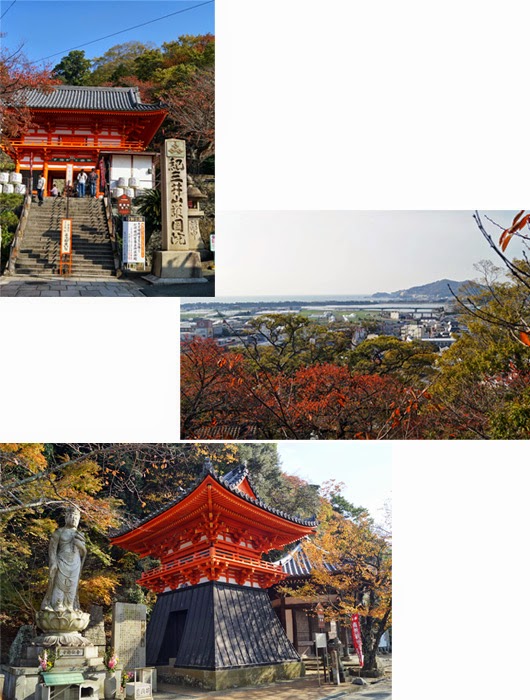紅葉と海の幸を求めて和歌浦に行きました。
< 1. autumnal leaves in Kimiidera( temple) >
< 1. 紀三井寺の紅葉 >
We went to Wakayama October
24, 25.
My wife planned this
trip for her mother, but, as for me, a dinner and a hot spring were the biggest
pleasure.
On the first day, we looked at
Kimiidera(temple), Tamatsujima Shrine, Kishu-Toshogu( Shrine) and stayed at a
hotel of Saikazaki.
On the next day, we went to Kuroe town of
lacquerware, Kuroshio market of seafood, Yuasa town of soy sauce and mandarin
orange
It was fine on the first day, but it was
clouded from the evening, and it was rainy from the start of the next day.
10月24日、25日、和歌山に行きました。
この旅行は、妻が母の為に企画したのですが、私は夕食と温泉が最大の楽しみでした。
初日は、紀三井寺、玉津島神社、紀州東照宮を見て、雑賀崎の宿に泊まりました。
次の日は、漆器の町黒江、海の幸の黒潮市場、みかんと醤油の町湯浅に行きました。
初日は、晴れだったのですが夕方から曇り初め、次の日は雨でした。
< 2. Kimiidera( temple) >
< 2. 紀三井寺 >
This temple worships Kannon Bodhisattva.
We can look over Wakanoura bay from the
precinct that we have climbed to on the stone stairway till the last.
The right hand of the
central photo is Saikazaki cape that we have booked to stay overnight.
The autumnal leaves seem
to have been overblown.
観音様を祀っています。
石段を登り詰めた境内からは和歌浦湾が一望出来ます。
中央の写真の右手が宿泊予定の雑賀崎です。
紅葉は盛りを過ぎたようです。
< 3. main approach of Kishu-Toshogu(
Shrine) >
< 3. 紀州東照宮の参道 >
< 4. a view of
Saikazaki fishing port from my hotel >
< 4. 宿から見た雑賀崎漁港 >
< 5. from an
observation deck near Takadushi-yama mountain >
< 5. 高津子山の手前にある展望台から >
< 6. the sights of Saigasaki cape >
< 6. 雑賀崎の見所 >
Upper fig.: a view of the rainy fishing port in the
morning from my hotel.
Lower fig.: autumnal leaves of Takadushi-yama mountain
上の図: 宿から見た雨に煙る朝の漁港。
下の図: 高津子山の紅葉。
< 7. my hotel “
ISARIBI-NO-YADO Seaside KANCHO” >
< 7. 宿「漁り火の宿 シーサイド観潮」 >
About this hotel
Good point of the hotel is that we can
thoroughly enjoy a nice view of the setting sun and the fishing port from a
room and a hot spring, the dining room.
Furthermore, the dinner
and breakfast were splendid.
Our room was old and inconvenient, but we
were satisfied with all the others.
This neighborhood is slightly desolate in
an old hot-spring hotel street.
It is surprising that
there was such a good place in Wakayama city.
The photo of the hot
spring was borrowed from HP of the hotel.
宿について
この宿の良さは、部屋や温泉、食堂から夕陽や漁港の眺めをたんのう出来ることです。
さらに海の幸の料理、夕食と朝食共に素晴らしかった。
部屋が古く不便なのですが、他はすべて満足出来ました。
この辺りは古い温泉旅館街で、少し寂しい。
和歌山市内にこのような良い所があるとは驚きでした。
温泉の写真は宿のHPから借用。
詳しくはhttp://www.kancho.co.jp/
Introduction of the dinner
The dinner was ingenious
seasoning, good setout, and considerate service.
We were able to enjoy
the cooking deliciously.
夕食の紹介
非常に行き届いた料理と盛り付け、配膳でした。
料理は素材を生かしながら、工夫が随所に見られ、美味しく楽しめました。
< 8. Dinner 1 >
Dish 1: Hors d’oeuvre.
Dish 2: Sashimi.
Dish 3: Fried skin of a hairtail.
Dish 4,5: Shabushabu of yellowtail (blanching).
I forgot to take a
picture of a homemade tofu and a tempura.
料理1: 先付;小さいながらどれも味わい深かった。
料理2: お造り盛り合。
料理3: 太刀魚の皮の唐揚げ。
料理4,5: ブリのしゃぶしゃぶ。
手作り豆腐と天ぷらの写真を取り忘れました。
< 9. Dinner 2 >
Dish 6: Grilled turban shell; a specialty dish in this hotel.
Dish 7: Stewed taro with
starchy sauce.
Dish 9: A clear soup of freshwater clam, and boiled
rice with sauce of grouper.
Dish 10: Dessert; a black ice cream.
Japanese dish was the
best.
And the outdoor bath
overlooking the cape was the best, too.
Yuasa town of manufacture of soy sauce
was also good as old town and it smelled good.
From the next time, I
return to “ Traveling to Spain and Portugal.”
料理6: サザエの壺焼き;この宿の名物料理「鷹の巣焼き」、美味しい。
料理7: 海老芋のあんかけ。
料理9: しじみのすまし汁とクエの利休飯(魚クエの汁かけご飯)
料理10: デザート;備長炭のアイスクリームだが見た目と違い、味は良い。
今回の食事はすべて海の幸にしたのですが、やはり日本料理は最高でした。
岬を見下ろす露天風呂も最高でした。
醤油の香りがする湯浅の醤油醸造の家並みも良かった。
次回から、スペインとポルトガルの旅行に戻ります。




































